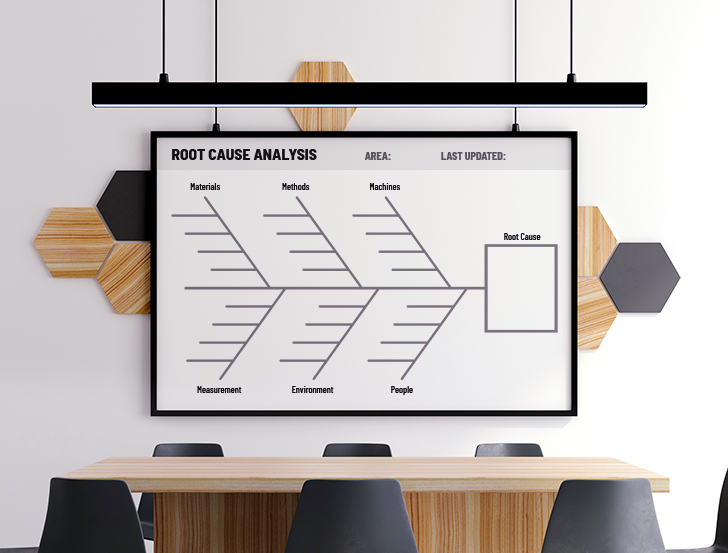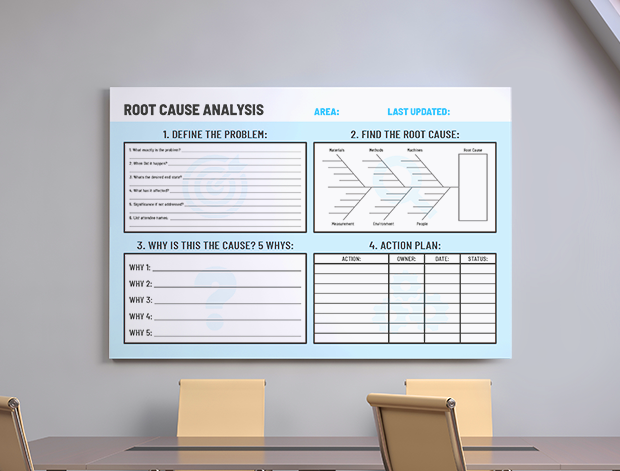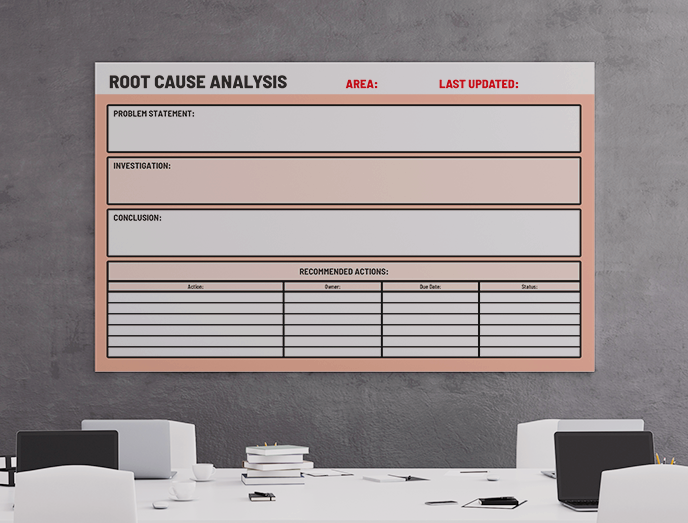03.
Structured
Problem Solving
Structured Problem Solving within a Lean or OPEX program is the use of proven methodologies such to resolve organisational issues or to highlight any potential opportunities for change. Used generally, problem solving is a method of continuous improvement that follows a six step approach.
These five steps include:
- 1. Identifying the problem
- 2. Isolating the cause
- 3. Applying a solution
- 4. Analysing the results
- 5. Standardising the solution
These five steps include:
- Identifying the problem
- Isolating the cause
- Applying a solution
- Analysing the results
- Standardising the solution
What are the most popular structured problem solving techniques?
There are multiple approaches to structured problem solving, but use of a particular technique depends on the nature of the problem, the stage you’re at in solving the problem as well as the angle that you would like to approach the problem.
This method highlights the potential root cause of a problem and where the problem might have arisen using the categories of Machine, Method, Measurement, Environment, Man and Materials.
This is an interrogative method that asks the same question why repeatedly, in order to give you 5 different possible reasons why a problem might be occurring. This can be used early in the problem solving process to identify the root cause.
The PDCA Method (Plan, Do, Check, Act) offers a structured way of testing small-scale solution implementations. This method allows people to initiate small changes and avoid preventable mistakes.
The DMAIC often involves a series of focused questions divided into the categories of define, measure, analyse, improve and control. This is a comprehensive method that promotes unbiased resolutions through structured preset questions. This is a useful technique due to its coverage in problem and solution identification and solution implementation.
A3 Description
The Benefits of Structured Problem Solving
Establishes standardised methods for future problem prevention.
Avoids unnecessary downtime through quick problem resolution.
Allows teams to take responsibility for process improvement.
Can be used for Strategy Development in general process improvement.
Products we suggest
The Ishikawa Fishbone Board
4 Step Root Cause Analysis Board
Basic Root Cause Analysis Board
PDCA Board
The Rule of 5 Board
Narrow down the suspective root cause of an issue by analysing any hiccups in the areas of Materials, Methods, Machines, Measurement, Environment & People.
This Board features a four step Root Cause Analysis Program to help Identify and implement a solution to any issue you might be having.
This Board features a three step Root Cause Analysis Program with recommended actions to help Identify and implement a solution to any issue you might be having.
This board is an important addition to any continuous improvement initiative as it helps your team test any possible resolutions to problems.
The rule of 5 board is an expansion onto the classic problem solving tool "The 5 whys" including 5 why nots as well as 5 Tries.
- The Ishikawa Fishbone Board
- 4 Step Root Cause Analysis Board
- Basic Root Cause Analysis Board
- PDCA Board
- The Rule of 5 Board
Case Study
In 2008 a study was carried out on the effect of the application of root cause analysis systems on product quality and productivity in a metal cutting factory and was published in The Journal of Industrial Engineering and Management (Mahto and Kumar 2008). The study focuses in on problems concerning defects in the CNC Oxy Flame cutting machine, material rejection and waste of time in non value adding activities.
The study addresses that there was always an aspect of material conservation. The study illustrates the defects in the CNC Cutting machine led to complications in the material itself, and subsequently led to fire-fighting to save the material. This is an example of non value adding activities and that through the total process time of 46 hours, 16 of those were for non value activities. As a result the factory staff conducted a series of root cause analysis problem solving that included Cause and Effect analysis, 5 Why Analysis and many others. The use of different methods is an advised strategy as it will give a refined view of multiple stages of the process and accommodate cross referencing.
Through the use of root cause analysis, multiple problems were highlighted. Such Problems included negligence of the recommended maintenance schedule of the machines as well as improper use of equipment as recommended specifications and settings for the machine were not adhered to. As a result, regular machine maintenance was scheduled and supplier settings were coded into the machine. Proper training and re-education was also implemented on the use of machines.
These changes had a considerable impact on the process showed an improvement on both product quality and productivity. The maintained machine with these recommended settings did not affect the material so much that non value added activities were needed to save material. Material rejection decreased from 11.87% to 1.92%. This increased productivity resulted in the issuing of new targets where they were going to produce 450 tonnes of product instead of their usual 250 tonnes.
This case study shows the knock on effect of preventable problems in the workplace and in particular manufacturing. Through the strategic use of problem solving techniques, the factory was able to resolve any defects caused by and in the CNC Oxy Flame cutting machine, introduce an effective machine maintenance schedule and highlight the need for training. Once initiated, the factory recorded an increase in product quality and productivity.
Read the full article here: https://www.econstor.eu/bitstream/10419/188371/1/v01-i02-p016_3-139-2-PB.pdf
Reference: Mahto, D., & Kumar, A. (2008). Application of root cause analysis in improvement of product quality and productivity. Journal Of Industrial Engineering And Management, 1(2).




